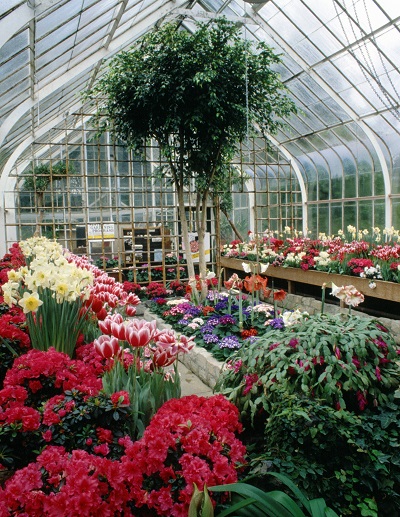
Lots of help for making this decision is available on the internet. Google searching the word “greenhouse,” finds 2,860,000 websites on the subject. A greenhouse is defined as “a structure with glass or plastic roof and frequently glass and plastic walls; it heats up because incoming solar radiation from the sun warms plants, soil, and other things inside the building faster than heat can escape the structure. Air warmed by the heat from hot interior surfaces is retained in the building by the roof and wall. These structures range in size from small sheds to very large buildings” (Wikipedia). It is the heat aspect of a greenhouse that requires the greatest consideration when determining the type of greenhouse structure to purchase to deal with the heat issue.
Before making a purchase, take advantage of all the information that is available on the Internet and in magazines, ask questions and talk with others who have a hobby greenhouse.
One criterion for greenhouse design is determined by its use, whether for commercial or hobby purposes. For the hobby grower, there is a wide range of designs, sizes, glazing (covering) materials and installed equipment that require consideration when making a choice. Price may also be a factor, not only its initial cost, but what it will take to maintain the greenhouse in good operating order. Appearance can be a factor, selecting a structure which blends in with its surrounding environment.
Some hobby greenhouses come in kit form, thereby relying on the purchaser’s skill to assemble the structure, or professional assistance may be required that may or may not be provided by the manufacturer or seller. Local building codes and ordinances may restrict the size and placement of a greenhouse and require a building permit.
Structural characteristics are important so that the greenhouse can withstand weather stresses, such as wind, hail, and snow, and be able to cope with weather extremes. A greenhouse that is attached to an already existing structure, i.e., house, shed, barn, etc., has different structural characteristics than that for a stand-alone. The greenhouse structural materials as well as service items within the greenhouse can serve as heat sinks, a value in cold weather, but less so when weather conditions are warm to hot.
The greenhouse glazing (cover) selection is a major decision since light transmission and back radiation characteristics vary considerably among the commonly used glazing materials. There is a loss of light intensity when passing through the glazing material, the extent of loss varying considerably, sometimes as much as 50% of the impinging radiation. In addition, there is also wavelength filtering. For example, glass is highly transparent in the longer wavelength portion of the light spectrum but filters out the shorter wavelengths. Although this may seem of little consequence, the shift in wavelength distribution will significantly affect plant growth.
At one time, I conducted the same tomato fruit production experiment in two differently glazed greenhouses that were just a few miles from each other, one glazed with glass, the other with fiberglass. In the glass-glazed greenhouse, the tomato plants had long internodes and the foliage was dull green in color, while in the fiberglass-glazed greenhouse, the plants had short internodes and the foliage color was a deep flush green. There was little difference in fruit yield, although there were some fruit quality differences favoring the plants being grown in the fiberglass glazed greenhouse. The major difference, however, was the labor requirement for tying and succoring, greater for the tomato plants being grown in the glass-glazed greenhouse. If plant architecture and leaf color are important factors, then the selection of the glazing material for the greenhouse is a major consideration.
Glass and some forms of clear polycarbonate materials will project direct sun light into the greenhouse, while opaque glazing materials will project diffuse light, with diffuse light creating less shadowing within the greenhouse. These light characteristics will affect both the air temperature regime within the greenhouse as well as plant growth. Also, the light and heat conditions within the greenhouse are determined by light intensity characteristics (percent cloudy conditions and day length) that vary with latitude and within local areas. Therefore, the selection of the greenhouse glazing material must take into consideration several factors, therefore not a simple decision to make.
Since a greenhouse is an efficient solar collector, it is relatively easy to heat, but can be very difficult to cool. Most small greenhouse structures have no mechanical provision (such as exhaust fans) for removing warm (hot) air from the structure, other than opening the entrance door and/or opening a vent in the gable of the greenhouse, allowing for the natural flow of hot air from the gable, that in turn, draws outside air into the structure through openings in the greenhouse, such as a door. In those instances when cooling is an important factor, having ridge vents that can be opened may be a necessary fixture for the greenhouse.
The greenhouse should be oriented, so the sun’s passage goes over its width. It should be placed where it will not be buffeted by wind, and not set in an area that harbors stagnant air. If there is shadowing from other structures or tall trees, the greenhouse should be placed so that it receives full morning sun and is shadowed from afternoon sun, not the other way around.
In some climatic environments, a greenhouse without installed climatic controls will be useable only during the transition periods of spring and fall. As mentioned earlier, heating a greenhouse is much easier to do than attempting to keep one cool during periods of warm to hot outside air temperature conditions, particularly during high light intensity days (cloudless days). Humidity control is another challenge, particularly during periods of changing air temperatures (night versus day) and periods of wet atmospheric conditions. High humidity is an invitation for plant foliage diseases. Being able to keep air moving within the greenhouse structure under hot humid conditions will be of significant benefit to plants. Stagnant air is a significant detriment to good plant growth, with nutrient element deficiencies, slow growth, poor plant appearance, and disease occurrences more likely.
The need for lights in the greenhouse depends on the plants being grown and day length. Numerous studies have shown little advantage using lights during daylight hours, but benefits can be obtained using lights to extend day length. There is a wide range of lamp factors, such as intensity and wavelength coverage. In addition, some lamps have blast requirements. Lamps can generate considerable heat that must be dispensed. The use of lights must be balanced between their cost and derived benefit with use.
To enhance the appearance of the area around a greenhouse, one is tempted to place flowers and/or shrubs to help the structure blend with the surrounding landscape. But that may not be a good idea as these plants may be harbingers of insects and diseases that will then have easy access to the plants in the greenhouse. Maintaining a fairly “sterile” environment around the greenhouse is the wise decision. Remember that the greenhouse is like a motel with a lighted “vacancy” sign welcoming insect, disease organisms, and other critters to spend the night or even longer. Also be prepared to handle these unwelcome “guests.”
Airtight structures have both advantages and disadvantages. The major advantages of a tight structure are that it prevents the loss of conditional air from the greenhouse, keeps unwanted air and organisms from entering the greenhouse. But without providing for expansion and contraction of the structural components, the structure may begin to come apart. A firm greenhouse foundation as well as firm flooring within the greenhouse adds considerably to structural integrity. A friend purchased a hobby 10×30 polycarbonate covered greenhouse without installed heating or cooling devices and placed the structure on a thin layer of gravel. After several years, the structure began to bend and change shape creating gaps between the polycarbonate sheets. Joined pieces began to break apart and although the structural material was “treated” wood, the exposed pieces began to decay from long periods of “wet” conditions (condensation) that occurred within the greenhouse.
For many hobby growers, having a greenhouse can significantly enhance one’s ability to expand the range of plant activities, such as early initiation and extension of the growing season, allowing one to grow plants out of season as well as plants not adapted to the local climatic conditions. Choosing the right greenhouse structure and being prepared to cope with the challenges it may offer will ensure success and hours of gardening pleasure.
Dr. J. Benton Jones, Jr. has a PhD in Agronomy and is the author of several books. Dr. Jones has written extensively on hydroponic growing and outdoor vegetable gardening employing sub-irrigation hydroponic growing systems.
Related Articles & Free Email Newsletter Sign Up
Greenhouse Structure and Frame Materials Overview
How to Properly Open a Greenhouse for Spring
The 10 Biggest Misconceptions about Greenhouse Polycarbonate




Comment here